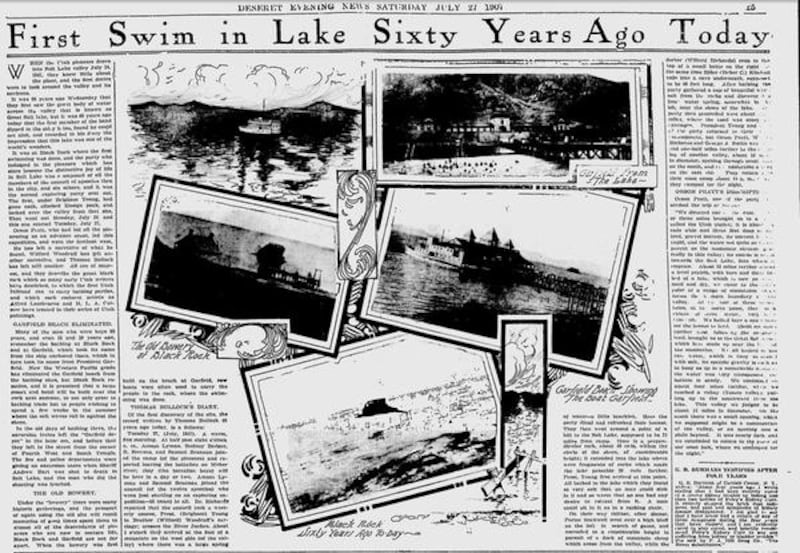A significant number of northern Utah residents have probably never waded or swam in the Great Salt Lake.
However, some of the first group of Mormon pioneers wasted little time in taking a dip in the briny lake waters, just three days after entering the Great Salt Lake Valley.
According to Milton R. Hunter in his 1956 book titled “Utah in Her Western Setting,” on July 27, 1847, eight apostles of The Church of Jesus Christ of Latter-day Saints and six other pioneers traveled southwest to the south end of the Great Salt Lake. They called the place Black Rock and ate lunch and swam in the lake there. The rock rose some 50 feet above the lake’s waters.
Orson Pratt reported: “We cannot sink in this water. We roll and float on the surface like a dry log. I think the Salt Lake is one of the wonders of the world.”
The Deseret News on July 27, 1907, also examined that first pioneer lake swim on its 60th anniversary and stated that a man could sit in the lake’s waters as a man sits in a rocking chair — suspended upward. The first pioneers in the water also reported the waters to be so warm that no one wanted to retreat from the lake.

Orson Pratt further described the water as fully saturated with salt, “its specific gravity as such to buoy us up in a remarkable manner, the water was very transparent; the bottom is sandy.”
After bathing, the pioneer group gathered a cup of white salt from the lake shore rocks and also discovered a fresh-water spring nearby, though it was somewhat brackish in taste.
The tradition soon became part of the Fourth of July celebration in Salt Lake City — going west and swimming in the briny waters of the lake. The Deseret News reported this happening on July 4, 1851.
Eventually, the first Utah railroad would transport bathers to Black Rock. Soon, a bowery was built at nearby Garfield Beach and rowboats would take swimmers out to Black Rock, where the water was deeper for proper bathing.
Black Rock was opened as a Great Salt Lake resort by H.J. Faust in 1876, but it soon fell into disrepair. Alonzo Hyde, son-in-law of LDS Church President John Taylor, and David John Taylor, the president's son, took over Black Rock in 1880. It was located a few miles northeast of Lake Point. Heber C. Kimball's old ranch house there was turned into a hotel, and the resort had swings and a merry-go-round, pulled by a horse.
Yet a much larger and grander resort, Saltair, opened about a mile to the east in 1893 and captured most of the headlines and crowds. In the Great Salt Lake’s heyday, eight different lakeshore resorts were operating, offering “floating like a cork.”
Famous naturalist John Muir visited and bathed in the Great Salt Lake on a cool and windy day in early May of 1877.
“Great Salt Lake. America’s Dead Sea Poetically Pictured by a Naturalist. Prof. Muir’s Bath at Lake Point” was the headline in the Salt Lake Herald newspaper.
Muir was alone on the south shore during his “swim” and assumed that was because cooler spring weather didn’t attract the crowds that the summer season did.
In Muir’s own poetic writing, here is a summary of his experience in the waters of the Great Salt Lake, as recorded in the Salt Lake Herald newspaper of June 27, 1877:
“When the north wind blows bathing in Salt Lake is a glorious baptism, for then it is all wildly awake with waves, blooming like a prairie in snowy crystal foam. Plunging confidently into the midst of the grand uproar you are hugged and welcomed and swim without effort, rocking and whirling up and down and round in delightful rhythm while the wind sings in chorus and the cool, fragrant brine searches every fibre of your body, and at the end of your excursion you are tossed ashore with a glad God-speed, braced and salted and clean as a saint.”
(What did Muir think of the Wasatch Mountains? His own description from that 1877 visit compared it to his Yosemite: “The mountains rise into the cool sky, furrowed with canons almost Yosemtic in grandeur and filled with a glorious profusion of flowers and trees. Lovers of science, lovers of wilderness, lovers of pure rest will find here more than they ever may hope for.”)
The Salt Lake Herald of Sept. 9, 1877, also made miraculous claims about the Great Salt Lake’s healing powers, which may have also contributed to the briny water’s extreme popularity in the late 19th century. The newspaper claimed the lake’s waters cured skin diseases, eased sore eyes and cleaned out the nose and throat.
“Great Salt Lake is beginning to take rank as a watering place. … Hundreds of the afflicted are testing its curative powers,” the newspaper reported.
Lynn Arave worked as a newspaper reporter for more than 40 years. He is a retired Deseret News reporter/editor, from 1979-2011. His email is: lra503777@gmail.com His Mystery of Utah History blog is at http://mysteryofutahhistory.blogspot.com



